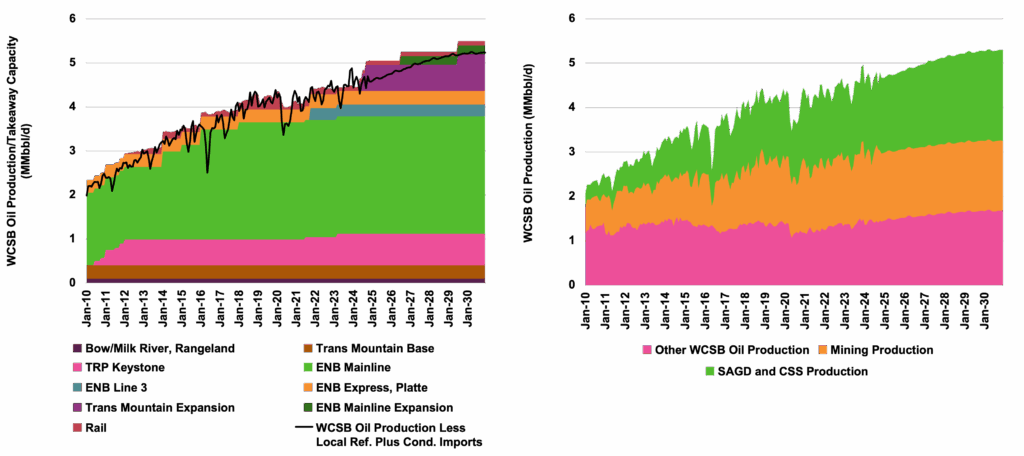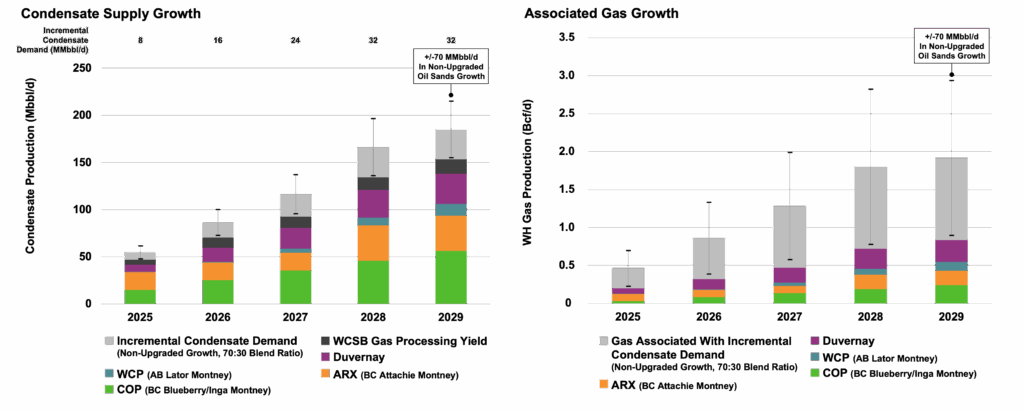Insights on WCSB Oil Production Pipeline Expansions, and AECO Hub Gas Pricing
The Canadian oil and gas industry is at a pivotal moment, with significant potential on the horizon that could reshape the landscape. Enverus Intelligence® Research (EIR), a subsidiary of Enverus, recently published the report, “Oil Sands Play Fundamentals” which takes a deep dive into these changes, providing crucial insights for industry stakeholders. Canada is anticipated to be one of the top four contributors to global oil supply growth over the next five years, with 65% of the country’s growth coming from oil sands – a significant wedge in global production that should not be ignored.
Let’s look at some of the key highlights:
- Anticipate a rise in oil production within the Western Canada Sedimentary Basin (WCSB).
- Explore the impact of increased oil sands production on the Canadian condensate and AECO gas markets.
- What to consider as an active producer or investor in the oil sands.

We see good and bad news for Canadian gas producers trying to capitalize on increased oil sands production over the next four years.
– Trevor Rix, Director, EIR

Rising Oil Production in the WCSB
The WCSB is poised for a significant increase in oil production led by SAGD project expansions. We expect existing oil pipelines to be filled by 2027. However, incremental expansions on Enbridge’s Mainline and the Trans Mountain Expansion pipeline, which EIR expects will each add 200 Mbbl/d by the end of the decade, will provide ample egress capacity towards the end of the decade. These expansions are key to our optimistic view on WCSB pricing over the medium term. The ability to transport more oil efficiently will not only support higher production levels but also stabilize prices, benefiting producers and the broader economy.


Every discussion about Canadian oil and gas markets starts and ends with
takeaway capacity.
– Dane Gregoris, Managing Director, EIR

Impact of Increased Oil Sands Production on Condensate Demand and AECO Hub Gas Pricing
The increase in oil sands production is set to drive substantial demand for in-basin condensate volumes, which are essential for diluting bitumen for pipeline transportation. Non-upgraded Canadian oil sands production is expected to rise by around 100 Mbbl/d annually until 2028. This surge will create a significant need for condensate, particularly from the Montney play in Alberta and B.C.
However, this increased demand for condensate will also have implications for AECO hub gas pricing. As Montney E&Ps pivot towards condensate-directed drilling, they will likely produce large quantities of associated gas. This could lead to an oversupply of cheap gas, putting downward pressure on AECO hub prices. While this scenario presents challenges for dry gas producers, it also underscores the importance of strategic planning and investment in liquids-rich areas.

Investment Opportunities and Risks: Low-Breakeven Canadian Resource Advantage
The primary benefit of Canadian oil sands and Montney assets lies in their extensive inventory of low-cost resource. Montney- and oil sands-exposed E&Ps tend to trade at similar FCF multiples to U.S. shale peers despite retaining two to three times the duration of sub-$50 WTI breakeven resources. In other words, these Canadian plays offer low-cost assets that remain economically viable over an extended period, providing a stable and attractive investment opportunity.

Investors should look at companies with exposure to liquids-rich areas of the prolific Montney play in Alberta and B.C, the largest source of gas in Canada, as well as select midstreamers, the companies that gather and process the gas and liquids.
– Trevor Rix, Director, EIR

The Canadian oil and gas industry is entering a dynamic period of growth and change. By understanding the key drivers behind rising oil production in the WCSB, the growth of oil sands projects, and the low-breakeven resource advantage, industry stakeholders can better navigate the evolving landscape. Strategic planning and investment will be crucial in seizing the opportunities and mitigating the risks ahead.
Join us at EVOLVE 2025 May 12-15 in Houston, TX to engage with Enverus analysts and hear from industry leaders on the future of energy.
What are your views on the future of the Canadian oil and gas industry? Let us know below, or subscribe to our blogs for more insights and updates on the energy sector.
About Enverus Intelligence Research
Enverus Intelligence® | Research, Inc. (EIR) is a subsidiary of Enverus that publishes energy-sector research focused on the oil, natural gas, power and renewable industries. EIR publishes reports including asset and company valuations, resource assessments, technical evaluations and macro-economic forecasts; and helps make intelligent connections for energy industry participants, service companies and capital providers worldwide. Enverus is the most trusted, energy-dedicated SaaS company, with a platform built to create value from generative AI, offering real-time access to analytics, insights and benchmark cost and revenue data sourced from our partnerships with 95% of U.S. energy producers, and more than 40,000 suppliers. Learn more at Enverus.com.







